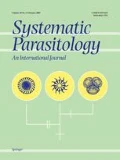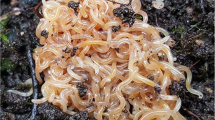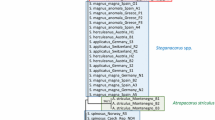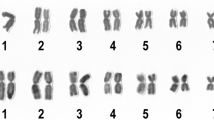Abstract
Genetic variation of Contracaecum ogmorhini (sensu lato) populations from different otariid seals of the northern and southern hemisphere was studied on the basis of 18 enzyme loci as well as preliminary sequence analysis of the mitochondrial cyt b gene (260 bp). Samples were collected from Zalophus californianus in the boreal region and from Arctocephalus pusillus pusillus, A. pusillus doriferus and A. australis from the austral region. Marked genetic heterogeneity was found between C. ogmorhini (sensu lato) samples from the boreal and austral region, respectively. Two loci (Mdh-2 and NADHdh) showed fixed differences and a further three loci (Iddh, Mdh-1 and 6Pgdh) were highly differentiated between boreal and austral samples. Their average genetic distance was D Nei=0.36 at isozyme level. At mitochondrial DNA level, an average proportion of nucleotide substitution of 3.7% was observed. These findings support the existence of two distinct sibling species, for which the names C. ogmorhini (sensu stricto) and C. margolisi n. sp., respectively, for the austral and boreal taxon, are proposed. A description for C. margolisi n. sp. is provided. No diagnostic morphological characters have so far been detected; on the other hand, two enzyme loci, Mdh-2 and NADHdh, fully diagnostic between the two species, can be used for the routine identification of males, females and larval stages. Mirounga leonina was found to host C. ogmorhini (s.s.) in mixed infections with C. osculatum (s.l.) (of which C. ogmorhini (s.l.) was in the past considered to be a synonym) and C. miroungae; no hybrid genotypes were found, confirming the reproductive isolation of these three anisakid species. The hosts and geographical range so far recorded for C. margolisi n. sp. and C. ogmorhini (s.s.) are given.
Similar content being viewed by others
References
Bullini, L., Arduino, P., Cianchi, R., Nascetti, G., D'Amelio, S., Mattiucci, S., Paggi, L., Orecchia, P., Plotz, J., Berland, B., Smith, J.W. & Brattey, J. (1997) Genetic and ecological research on anisakid endoparasites of fish and marine mammals in the Antarctic and Arctic-Boreal regions. In: Battaglia, Valencia & Walton (Eds) Antarctic communities. Species, structure and survival. Cambridge: Cambridge University Press, pp. 39–50.
Brewer, G.J. & Sing, C.F. (1970) An introduction to isoenzyme techniques. New York & London: Academic Press, 186 pp.
Campana-Rouget, Y. & Paulian, P. (1960) Mise en synonymie de deux espèces de Contracaecum, parasites de mammiferes marins. Annales of Parasitologie Humaine et Comparée, 35, 191–192.
D'Amelio, S., Mattiucci, S., Paggi. L., Orecchia, P., Nascetti, G., Cianchi, R., Bullini. L. & Margolis, L. (1994) Genetic variation of the pinniped parasite Contracaecum ogmorhini (Ascaridida, Anisakidae). Parassitologia, 36 (suppl.), 40.
Dailey, M.D. (1978) Baseline data on parasites from marine mammals in Southern California. In: Marine mammals and seabird survey of the Southern California Bight area. Vol. III. Principal investigator's reports. Book 1. Pinnipedia, Cetacea and Parasitology. pp. 442–472.
Fagerholm, H.P. (1988) Patterns of caudal papillae in Contracaecum osculatum (Nematoda) and some related species from different regions of the world. International Journal for Parasitology, 18, 1039–1051.
Fagerholm, H.P. (1989) Intra-specific variability of the morphology in a single population of the seal parasite Contracaecum osculatum (Rudolphi) (Nematoda: Ascaridida) with a redescription of the species. Zoologica Scripta, 18, 33–41.
Fagerholm, H.P. & Gibson, D.I. (1987) A redescription of the pinniped Contracaecum ogmorhini (Nematoda, Ascaridoidea) with an assessment of its antiboreal circumpolar distribution. Zoologica Scripta, 16, 19–24.
Harris, H. (1966) Enzyme polymorphism in man. Proceedings of the Royal Society, Series B, 164, 298–310.
Hartwich, G. (1975) Rhabditida und Ascaridida. Tierwelt Deutschland, 62, 1–256.
Jeanmougin, F., Thompson, J.D., Gouy, M., Higgins, D.G. & Gibson, T.J. (1998) Multiple sequence alignment with Clustal X. Trends in Biochemical Sciences, 23, 403–405.
Johnston, T.H. & Mawson, P.M. (1941) Nematodes from Australian marine mammals. Records of the South Australian Museum 6, 429–434.
Johnston, T.H., & Mawson, P.M. (1945) Parasitic nematodes. Reports of the British, New Zealand and Australian Antarctic Research Expedition, Series B, 5, 74–159.
Kumar, S., Tamura, K., Jakobsen, I.B. & Nei, M. (2001) MEGA2: Molecular evolutionary genetics analysis software. Bioinformatics (in press).
Lent, H. & Freitas, J.F.T. (1948) Uma colecao de nematodoes, parasitos de vertebrados, do Museu de Historia Natural de Montevideo. Memórias do Instituto Oswaldo Cruz 46, 1–71.
Mattiucci, S., Nascetti, G., Cianchi, R., Paggi, L., Arduino, P., Margolis, L., Brattey, J., Webb, S.C., D'Amelio, S., Orecchia, P. & Bullini, L. (1997) Genetic and ecological data on the Anisakis simplex complex with evidence for a new species (Nematoda, Ascaridoidea, Anisakidae). Journal of Parasitology, 83, 401–416
Mattiucci, S., Paggi, L., Nascetti, G., Ishikura, H., Kikuchi, K., Sato, N., Cianchi, R. & Bullini, L. (1998) Allozyme and morphological identification of Anisakis, Contracaecum and Pseudoterranova from Japanese waters (Nematoda, Ascaridoidea). Systematic Parasitology, 40, 81–92.
Mattiucci S., Paggi L., Nascetti G., Abollo E., Webb, S.C., Pascual., S., Cianchi, R. & Bullini, L. (2001) Genetic divergence and reproductive isolation between Anisakis brevispiculata and Anisakis physeteris (Nematoda: Anisakidae). International Journal for Parasitology, 31, 9–14.
Nascetti, G., Cianchi, R., Mattiucci, S., D'Amelio, S., Orecchia, P., Paggi, L., Brattey, J., Berland, B, Smith, J.W. & Bullini, L. (1993) Three sibling species within Contracaecum osculatum (Nematoda, Ascaridida, Ascaridoidea) from the Atlantic Arctic Boreal region: reproductive isolation and host preferences. International Journal for Parasitology, 23, 105–120.
Nei, M. (1972) Genetic distance between populations. The American Naturalist, 106, 283–292.
Okimoto, R., Macfarlane, J.L., Clary, D.O. & Wolstenhome, D.R. (1992) The mitochondrial genomes of two nematodes, Caenorhabditis elegans and Ascaris suum. Genetics, 130, 471–498.
Poulik, M.D. (1957) Starch gel electrophoresis in a discontinuous system of buffers. Nature, 180, 1477.
Richardson, B.J., Baverstock, P.R. & Adams, M. (1986) Allozyme electrophoresis. A handbook for animal Systematics and Population studies. Sydney: Academic Press, 410 pp.
Ridgway, S.H. & Harrison, F.R.S. (1981) Handbook of marine mammals. Vol. 1. The walrus, sea lions, fur seals and sea otter. London: Academic Press, 235 pp.
Rogers, J.S. (1972) Measures of genetic similarities and genetic distance. Studies in Genetics VII, University of Texas Publications, 7213, 145–153.
Selander, R.K, Smith, M.H., Yang, S.Y. & Gentry, J.B. (1971) Biochemical polymorphism and systematics in the genus Peromyscus. I. Variation of the old-field mouse (Peromyscus po23 lionotus). Studies in Genetics VI, University of Texas Publications, 7103, 49–90.
Swofford, D.L. & Selander, R.B. (1989) BYOSYS-1, a computer program for the analysis of allelic variation in population genetics and biochemical systematics, version 1.7. Champaign: Illinois Natural History Survey, 31 pp.
Wright, S. (1943) Isolation by distance. Genetics, 28, 114–138.
Wright, S. (1951) The genetical structure of populations. Annals of Eugenics, 15, 323–354.
Wright, S. (1978) Evolution and the genetics of populations. Vol. 4. Variability within and among natural populations. Chicago: The University of Chicago Press, pp. 580.
Zhu, X., D'Amelio, S., Hu, M., Paggi, L. & Gasser, R. (2001) Electrophoretic detection of population variation within Contracaecum ogmorhini (Nematoda: Ascaridoidea: Anisakidae). Electrophoresis, 22, 1930–1934.
Author information
Authors and Affiliations
Rights and permissions
About this article
Cite this article
Mattiucci, S., Cianchi, R., Nascetti, G. et al. Genetic evidence for two sibling species within Contracaecum ogmorhini Johnston & Mawson, 1941 (Nematoda: Anisakidae) from otariid seals of boreal and austral regions. Syst Parasitol 54, 13–23 (2003). https://doi.org/10.1023/A:1022145926409
Issue Date:
DOI: https://doi.org/10.1023/A:1022145926409




